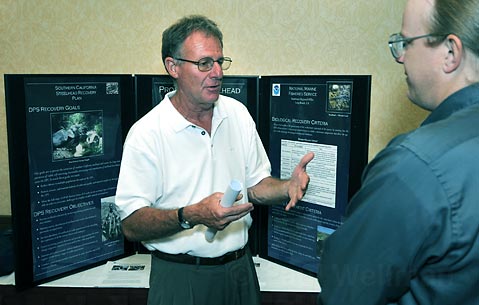Endangered Fish Fry
Environmental Group Sues Fire Agencies for Using Toxic Retardant

When dead fish turned up in a section of Maria Ygnacio Creek running through Robert Bjorklund’s property during the first week of May 2009, few were concerned. Most people in town had their attention turned toward the then-raging Jesusita Fire, which fire agencies were battling hard to keep it from ripping toward Goleta. Bjorklund, however, noticed that the fish he saw floating belly-up in the creek-which were tinted orange from dropped fire retardant-happened to be endangered steelhead trout. So he made a few calls in order to get someone up to his property to investigate. Within a few days, scientists from UCSB and the National Marine Fisheries Service were on site collecting samples. In all, they found more than 40 dead steelhead and ammonia levels that were 100 times higher than normal.
Numbers were crunched and reports were filed, but nothing happened until December 16, when the Forest Service Employees for Environmental Ethics (FSEEE)-an environmental nonprofit focused on protecting whistle-blowers and pushing reform of the Forest Service’s land use policy-announced that it had filed notice with the U.S. Department of Commerce outlining plans to file suit against the California Department of Forestry and Fire Protection and the Santa Barbara County Fire Department. FSEEE maintains that the two fire protection agencies used a toxic fire-retardant material that killed endangered steelhead trout during the Jesusita Fire last May. “I’m not in this thing to make the fire department look bad,” said Bjorklund. “I just thought it was my duty to report it.”
In accordance with the Endangered Species Act, FSEEE must wait 60 days before it can actually file a lawsuit. “That is to give the Department of Commerce an opportunity to do what this lawsuit would do, and that is enforce the Endangered Species Act. This lawsuit goes forward only if the government chooses not to enforce this law,” said Andy Stahl, FSEEE’s executive director, explaining that the Department of Commerce can request that the fire agencies implement a habitat conservation plan setting up specific guidelines regarding where and how fire retardant can be dispersed. Scott Cooper, the UCSB scientist who measured high ammonia concentrations in Bjorkland’s run of Maria Ygnacio Creek, said that the Forest Service already has such guidelines in place, requiring that fire retardant be kept at least 300 feet from creeks. “The terrain here is tricky. It’s difficult to see where the streams are,” he said, noting that dense foliage often obscures streambeds from the view of fire aircraft.

Captain David Sadecki, a spokesperson for the Santa Barbara County Fire Department, said that he could not comment on the effects of fire retardants, as the agency itself doesn’t actually use it, relying instead upon retardant drops by CalFire and the Forest Service. In a report on his May 11 investigation of Bjorklund’s property, National Marine Fisheries Service steelhead recovery coordinator Mark Capelli said that CalFire officials supplied him with maps corroborating that retardant had been dropped just east of Maria Ygnacio Creek. A materials safety data sheet on the retardant (called Phos-Chek) included in the report indicated that it is “practically nontoxic” to several species of birds and fish, including rainbow trout. Although Cooper found that the level of ammonia was at less than toxic levels when he arrived, it was still 100 times higher than normal. But he maintains that because it tends to dissipate quickly, levels were likely much higher when the retardant had been dropped six days before he took his readings.
Recently, Bjorkland has noticed that steelhead have already started to repopulate the creek near his house. Although the fish are coming back, the legal fallout surrounding the ones that died during the fire has a way to go. Daniel Berlant, a CalFire spokesperson, said that his outfit doesn’t yet know enough about FSEEE’s claims to comment, adding that since the investigation took place in May, no one from the Marine Fisheries Service has contacted either fire agency.



